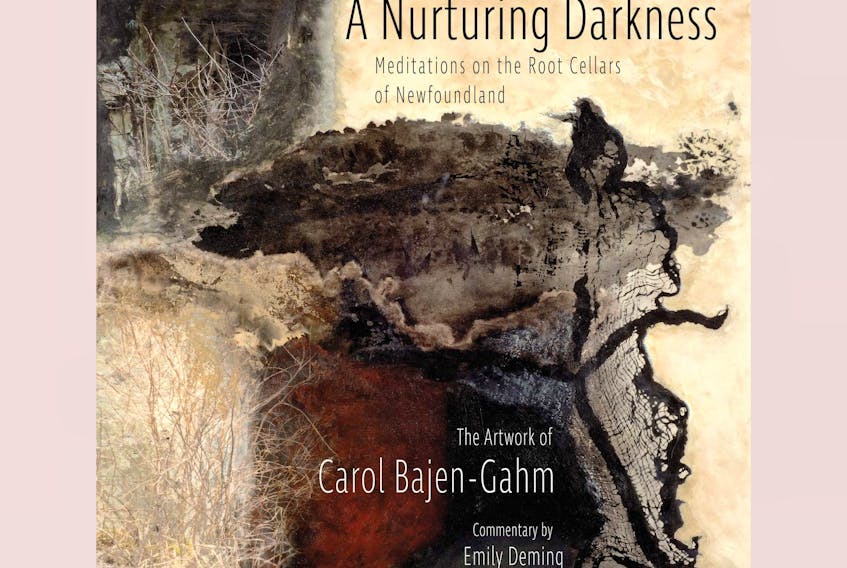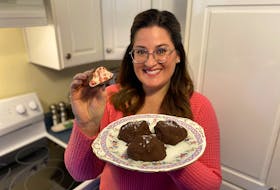Carol Bajen-Gahm is Massachusetts-born, now producing out of a studio in Torbay where she focuses on mixed media. As such she blends an incredible variety of materials: the pieces featured herein are made with encaustic, oil, seaweed paint, netting, photo transfers, and other media.
As both Bajen-Gahm and essayist Emily Deming explain, this technique differs from collage.
This is an over-simplification (mine), but collages are often meant to show the edges, the contrasts between the stuff; Bajen-Gahm’s positioning and purpose compacts the overlay and infusion, while preserving the diversity of surface, marrow, and tone.
“My grandfather, a Presbyterian missionary, impressed on me the importance of living a life of service,” Bajen-Gahm explains in her artist’s statement. “He believed that the disciplines of art and music were inflated and frivolous life paths.” Fortunately for the viewer, “This never made sense to me …”
Deming’s introduction positions the series as the outcomes of a very physical process, something that is “with me when I shovel snow. The physical work of it. The layers. Chipping away at some, sluffing off more. Going in hard to be met with ease, then relaxing only to come up on ice or rock. Shades of white yellow grey black gravel water rock salt.”
Root cellars are an acclaimed form of vernacular Newfoundland architecture — with Elliston proclaimed the root cellar capital of the world — a handy, hardy. and effective method of storing root vegetables through the winter. But these are not realistic representations of root cellars.
“The corner of three planes meeting, forms the entrance into Bajen-Gahm’s ‘Root Cellar Meditations’,” Deming writes. “But the way in is less direct. The careful balance of the elements in each piece refuses to direct us where to begin. The doorways become objects; the objects are paths to unseen worlds. She admits she intentionally obscures perspective with an ‘element of trying to be evocative.’ Are you looking at something, or is that ‘something’ something else?” Sometimes there is, clearly, a doorway. But there are also other ways in.
“Like every true fairy tale, choice is as powerful as fate,” Deming continues. “Also like fairy tales, these pieces are about place. Place through colour and shape. Place ‘funnelled through the subconscious’ and abstracted by the artist. The sense of depth and danger is very real, and the colours she pulls from everywhere around her.
“The colours in these works ‘bloom mysteriously out of the dark.’ Each series she does brings out a certain element of colour, though Bajen-Gahm ‘tr(ies) not to be seduced by it.’ She uses ‘tertiary colours’ (where at least three colours are mixed to form the right one).”
The encaustics have as many as seven tints. Sumi ink lends itself to prints of damp seaweed. Charcoal and graphite add blacks — Bajen-Gahm wants as many as she can get, and with them “browns decaying to gold; blues so dense they must be generating their own light as none could penetrate through the ferocity of the colour; rusts that are almost an action, a growth, a puddle, proof of happening.”
Deming then distills Bajen’s-Gahm’s working approach to a wielding of restraint and control.
Next, the series is laid out in two-page spreads, usually with an image on one, and the title, dimensions, and date facing it; sometimes the imagery fills two pages; sometimes it is offset with a detail.
For example, “Root Cellar #1” is bunched and crumpled lace, “#27” striated and meshed, “#4” (they are not arranged numerically) clouded and scaled. “#6” is like an armature, or skeleton, of some sort of animal encasement. Much of this is in greys, browns, and blacks against lighter grey or ivory, but others, like “#18”, shimmer with fractals of blues in many tones. “#21” places white and orange leaf-like forms in decomposition and erosion. “Root Cellar #24” holds a pulse that looks almost a cross of humanoid with jewelry. Motifs of aquatic foliage and tactile facades continue.
The book closes with full listing of works and whether and where they are available for sale.
“A Nurturing Darkness” strikes me as something unusual and yet an obvious niche-filler, a softcover art book as opposed to something “coffee table,” a kind of exhibition catalogue meant for broader consumption. The book itself has a pleasing shape and thickness and is easy to hold and read.
Joan Sullivan is editor of Newfoundland Quarterly magazine. She reviews both fiction and non-fiction for The Telegram.









